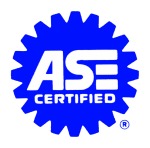Vehicle Service Records
A vehicle service record is the history of the maintenance and repair of your car. Every vehicle should have one. All too often we are too busy to keep service records. That failure can cost money. If you are like most people, you service your vehicle at more than one business. Sometimes you change oil at a quick service oil change center near your home. Other times you go to a place with a discount coupon. You buy tires at a warehouse outlet. Then go to an alignment shop when the steering pulls to the left. You buy a battery from an auto parts store and install it yourself. And you wait for something to go wrong before you head to the dealership or look for an auto repair shop. When you buy automotive services this way, you may save a few bucks in the beginning....
You Gotta Have Brakes
Brakes are the most important safety feature on your car. When they work properly your car stops smoothly, quietly and without pulling your vehicle to the right or left. In emergencies, they stop quickly without locking up, skidding and sending your vehicle out of control. Here are some typical problems with brakes. Noise Brake noise varies from a low groan at slow speeds (0-2 mph), to squeaks or squeals, to a rattle or grinding sound. A low speed groan on disc brakes suggests metal to metal contact or “glazed” brake pads and contact surfaces. A high pitched squeal at driving speeds means brake pad vibration. This can be a dirt contamination problem or a worn braking surface. A rattling noise indicates loose brake parts. Normally this is caused by worn springs...
New Cars Don’t Have Dip Sticks – A Guide to Transmission Maintenance and Service
Remember the days when transmission maintenance meant you periodically checked your transmission fluid level by pulling a metal dipstick from a tube alongside your engine? Well those days are rapidly coming to a close. Many new vehicles are doing away with the transmission dipstick and easily accessible tubes for adding fluid to your car’s transmission. Here is the reason for the change: a vehicle owner can damage a transmission by overfilling or putting the wrong transmission fluid in the car. Transmission fluid is not a generic item any more. Various manufacturers are installing fluids with specific formulas to match the precision internal components of modern transmissions. Use the wrong fluid and the transmission can fail long before the car’s new car...
Buying a Used Car and the Pre-Purchase Inspection
In today’s down economy good used cars are getting harder to find. New car sales are slow. Fewer used cars are being traded in. More people are holding on to good used cars and trucks. So where are the used cars coming from? About that Used Car Many used cars – particularly those found on small used car dealer lots – are coming from wrecked vehicle auctions. The lot operator buys the vehicle, makes cosmetic repairs and sells the vehicle as a clean used car. Some of these cars were so badly damaged they were declared total losses. If the vehicle has a salvaged title, you know it was in a major wreck and should carefully check the vehicle before purchase. But clean title – even when accompanied by a clear VIN check report from a vehicle history reporting...
Auto Repair Horror Stories – How to Avoid Them
You have heard the horror stories. You paid to have the auto repair shop fix the problem, but your car still does not run right. You take it back – they find something else – and the car still does not work. We recently saw a Honda CRV that was barely running. The owner experienced overheating problems and had taken it to a nearby mechanic. A thermostat was replaced. A week later the radiator cracked and it was replaced. The car continued to run hot until the engine began losing power. The mechanic could not find the cause. So the owner brought the car to us. Our diagnosis? A burnt valve requiring a major repair to the engine. The repair bill – over $2,500. The sad part about this story is the cause. Both of the vehicle’s electric radiator fans had...
Your Motor Needs Oil
Your engine is made of metal and contains metal parts. Those metal parts move. To keep the moving parts from destroying themselves through physical contact with each other, engines are designed to distribute a thin film of lubricant across the surfaces where metal would meet metal. The lubricant is oil. Oil is the life blood of your car’s engine. Without it, internal movement of engine parts would create excessive heat and friction. Metal parts would expand and warp and dig into each other, quickly causing the engine to fail. Automotive motor oil forms a thin barrier between metal parts allowing them to slip past each other without touching. Modern oils contain additives. These additives include rust and corrosion inhibitors, detergents, oxidation inhibitors,...









